
James Hall, Yuki MacQueen and John Eckstein
This is a story of how three musicians of the Utah Symphony ended up visiting Haiti and volunteering at a music camp, and what we saw and felt, and how it changed us.
It started with Janet Anthony, a very persuasive woman. Janet is the President of an non-profit organization called BLUME Haiti (an acronym for Building Leaders Using Music Education). It acts as an umbrella organization whose mission is “working with Haitian and international partners to develop leadership skills, awaken individual potential and create opportunities for social, civic and economic development through music education and performance.” Although Blume has only existed since 2012, Janet had been spending most of her summers teaching, performing and conducting in Haiti since 1996. Janet has been so committed to Haiti that she has brought volunteer college music students and fellow music educators from the USA and abroad to teach and perform at summer music camps throughout Haiti every year. She is a true woman of action, and we can’t decide if she has more in common with Dorothy DeLay (legendary violin pedagogue) or Indiana Jones.
During the school year, Janet is a cello professor at Lawrence University situated in Appleton, Wisconsin, a position she has held since 1984.
The intersection between my group of friends and Janet happens here. Utah Symphony cellist, John Eckstein, grew up near Appleton, Wisconsin, and his mother still lives there. He visits Appleton for the winter holidays and often for weeks during the summer.
John and Janet also happen to have studied with famed Russian emigre cellist, Raya Garbousova some years apart. They met decades ago when Janet happened to visit her teacher during one of John’s lessons.
When the disastrous earthquake of 2010 hit, Janet took an entire semester off from teaching at Lawrence University to go help regroup and rebuild the music schools and check on all of her musical friends in Haiti.
Janet asked if John was available as a visiting cello professor during her sabbatical, and so John took a leave of absence from the Utah Symphony to go teach at Lawrence.
While in Wisconsin, John saw much evidence of Janet’s love for Haiti. She often arranges for Haitian music teachers and students to come to the US for short-term professional development, often housing the guest in her own home. Her office bookshelves were also lined with books about Haitian history and current events.
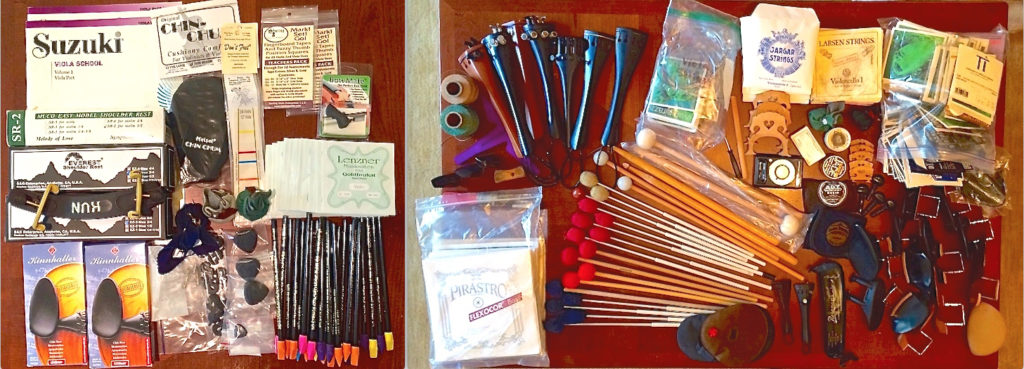 To support Janet’s efforts, John made a request to his Utah Symphony colleagues for donations of musical supplies. As a result, we collected boxes full of used and new strings, mouthpieces, mallets and other supplies. For John’s next trip to Wisconsin, he brought a large suitcase full of these donations, which Janet gladly accepted on behalf of BLUME Haiti. But the wheels were already turning in John’s mind, and he had a notion of actually volunteering his time in Haiti. By pure coincidence, our principal second violinist, Claude Halter, had attended Lawrence University, and knew Janet and her efforts in Haiti. During a Utah Symphony rehearsal break, John and Claude casually chatted about how maybe they’d volunteer in Haiti one day, but Claude already had summer plans for 2016.
To support Janet’s efforts, John made a request to his Utah Symphony colleagues for donations of musical supplies. As a result, we collected boxes full of used and new strings, mouthpieces, mallets and other supplies. For John’s next trip to Wisconsin, he brought a large suitcase full of these donations, which Janet gladly accepted on behalf of BLUME Haiti. But the wheels were already turning in John’s mind, and he had a notion of actually volunteering his time in Haiti. By pure coincidence, our principal second violinist, Claude Halter, had attended Lawrence University, and knew Janet and her efforts in Haiti. During a Utah Symphony rehearsal break, John and Claude casually chatted about how maybe they’d volunteer in Haiti one day, but Claude already had summer plans for 2016.
John mentioned the idea to James Hall and myself, and we almost immediately jumped on the idea of volunteering in Haiti. Seeing a new country and culture was the sort of thing that we both like to do, and we relished the opportunity to bridge cultural barriers. Janet had taught and performed in Haiti countless times before, and had brought college students there and back (presumably intact), so we knew that there would be adventure involved, but we knew it wasn’t all that risky.
Once we decided that we were really going to go, we started preparing each in our own way. James focused on the Haitian Creole language, listening to language podcasts, YouTube tutorials, and reading glossaries of terms, and scouring news articles on anything Haitian, John read several nonfiction books about recent history and politics in Haiti and I read several books of fiction by Haitian authors, and even watched a few Haitian movies and documentary films with English subtitles.
The one documentary that we all watched, and found extremely moving, was called “Kembe La”, chronicling the musical life at Saint Trinity Music School in Port-au-Prince, Haiti before, during and after the 2010 earthquake. It showed the dedication of the students, the creative energy, huge loss of life and infrastructure, and the will to rebuild and use the power of music in the healing process. https://www.youtube.com/watch?v=WM98NiwDvGA
Another part of our preparation involved buying supplies like mosquito nets, spraying our clothes with mosquito repellent (a serious Zika outbreak was unfolding), buying portable water filters and bottles, hand sanitizer etc., and visiting the Salt Lake International Travel Clinic to get the slew of inoculations required.
John had one more trip to Wisconsin in June, and knowing he was already committed to the Haiti trip, Janet mentioned that she and her volunteer students already had their hands full from other generous donations for this particular trip, and with the maximum baggage allowance set at 50 lbs, they couldn’t possibly carry his additional 35 pound suitcase.
Being the persuasive person she is, Janet masterfully convinced John to carry the suitcase of Utah Symphony donations all the way back to Utah to bring to Haiti himself.
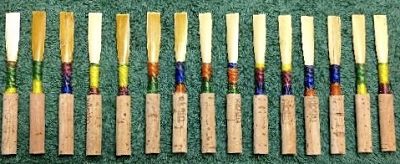 The three of us finally set off on our great adventure, and a red-eye and two flights later, we arrived in Port-au-Prince, Haiti. Our pre-arranged driver picked us up at the airport, and the three of us sat crammed, sweaty and greasy from mosquito repellant in the backseat shoulder to shoulder with no seatbelts trying to catch a breeze through the open windows, but mainly breathing in the heavy aroma of charcoal and burning trash. Wide eyed, and speechless with exhaustion and shock, we took in the scenery. I had seen the rubble, open sinkholes, canals overflowing with trash, wild pigs and wild dogs sniffing through the piles of garbage in plenty of documentaries, but I assumed the footage was of the worst spots. What we saw was a very large area, all similar. And the added stimulus of heat, humidity and smell made the situation very vivid. The three of us were eyeing each other to see if the others were feeling the same self-doubt. My friends were stoic, but the grim expressions and dusty sweat beads trailing down our cheeks were a good indication.
The three of us finally set off on our great adventure, and a red-eye and two flights later, we arrived in Port-au-Prince, Haiti. Our pre-arranged driver picked us up at the airport, and the three of us sat crammed, sweaty and greasy from mosquito repellant in the backseat shoulder to shoulder with no seatbelts trying to catch a breeze through the open windows, but mainly breathing in the heavy aroma of charcoal and burning trash. Wide eyed, and speechless with exhaustion and shock, we took in the scenery. I had seen the rubble, open sinkholes, canals overflowing with trash, wild pigs and wild dogs sniffing through the piles of garbage in plenty of documentaries, but I assumed the footage was of the worst spots. What we saw was a very large area, all similar. And the added stimulus of heat, humidity and smell made the situation very vivid. The three of us were eyeing each other to see if the others were feeling the same self-doubt. My friends were stoic, but the grim expressions and dusty sweat beads trailing down our cheeks were a good indication.
The trip to Grand Goave from the airport took a little over two hours, though technically it is a distance of about 40 miles from Port-au-Prince. This is normal, and we expected it, but with the lack of sleep and perplexing new environment it was a long two hours. In past years the Saint Trinity camp had taken place in two locations, one having been destroyed by the earthquake, and the second not available due to administrative complications. So this year, the camp was to take place at a new, untested location. This was a missionary compound, and though I knew that a walled camp would be good for security, we might not get a chance to see the neighborhood directly or mingle with the locals. I asked our driver to stop before we reached the compound to buy a few mangoes. Ladies with baskets of fresh picked ripe mangoes clamoured at the car window, and after buying a large bushel for an unbelievably low price, I was grateful throughout the week that I had the ultimate sweet treat when I needed a boost of energy.
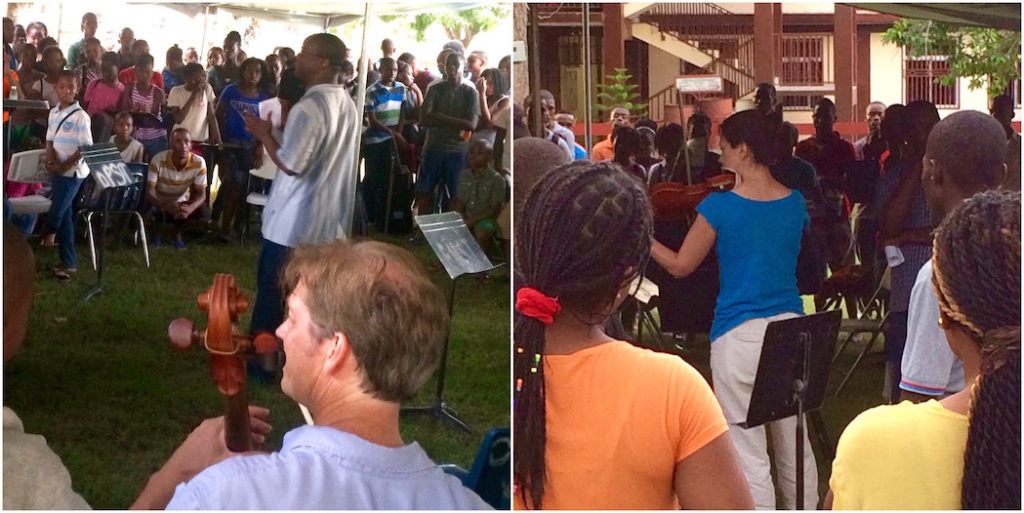 By the time we arrived through the gates of our summer camp, it was late in the afternoon. The rest of the volunteer teachers and many of the camp students had just relocated from another summer camp location far in the north, and had only arrived a day ahead of us, so we were all in a new environment. Of course, the three of us from Utah were especially delirious from our sleepless night (and probably under some influence of the malaria pills as well). Janet came out to meet us, and she was exactly as I had pictured her – a bundle of energy and positivity. Fluent in Haitian Creole, and seemingly at home in the tropics, she is absolutely the best ally one could have in unfamiliar circumstances. We were given a quick orientation, a light supper, put our suitcases in our assigned rooms, and joined everyone flocking around the central tent for a vespers gathering. This involved a few words of gratitude and encouragement in Haitian Creole by divinity professor and violinist, Ronald Charles, with whispered translation in English by Lindsay Schwartz (cellist and treasurer for BLUME-Haiti). There were a couple of songs sung also, and everyone seemed very familiar with these hymns. It was a beautiful moment, and hearing the mellifluous tones of the music sung in Creole, accompanied by tropical birds and insects in the background, and seeing the students ranging from elementary school age all the way to college age reminded us of the reason we came and wanted to participate. The gathering was calming, and it was repeated every morning and evening. Announcements were made at the end of the gathering, and the kids and volunteers went off for the evening orchestra rehearsals while we were given the evening off to acclimate.
By the time we arrived through the gates of our summer camp, it was late in the afternoon. The rest of the volunteer teachers and many of the camp students had just relocated from another summer camp location far in the north, and had only arrived a day ahead of us, so we were all in a new environment. Of course, the three of us from Utah were especially delirious from our sleepless night (and probably under some influence of the malaria pills as well). Janet came out to meet us, and she was exactly as I had pictured her – a bundle of energy and positivity. Fluent in Haitian Creole, and seemingly at home in the tropics, she is absolutely the best ally one could have in unfamiliar circumstances. We were given a quick orientation, a light supper, put our suitcases in our assigned rooms, and joined everyone flocking around the central tent for a vespers gathering. This involved a few words of gratitude and encouragement in Haitian Creole by divinity professor and violinist, Ronald Charles, with whispered translation in English by Lindsay Schwartz (cellist and treasurer for BLUME-Haiti). There were a couple of songs sung also, and everyone seemed very familiar with these hymns. It was a beautiful moment, and hearing the mellifluous tones of the music sung in Creole, accompanied by tropical birds and insects in the background, and seeing the students ranging from elementary school age all the way to college age reminded us of the reason we came and wanted to participate. The gathering was calming, and it was repeated every morning and evening. Announcements were made at the end of the gathering, and the kids and volunteers went off for the evening orchestra rehearsals while we were given the evening off to acclimate.
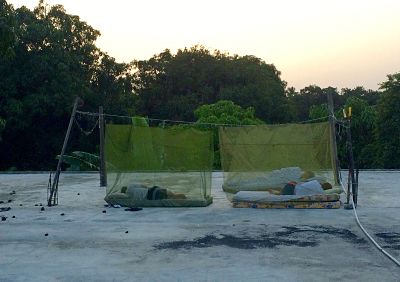 We explored the staff dorm building, which had a large communal kitchen area as well as an exterior kitchen on the ground floor where the local staff would prepare all meals from scratch. Large vats of beans, rice, gruel, were cooked over charcoal fires, and a large mortar and pestle were in near constant use mashing herbs and beans and everything else. Drinking water was available from a large dispenser, and the compound had its own electric generator that could provide light most of the time. The wi-fi that all of the staff were looking forward to having wasn’t working quite yet, and Janet had to make many phone calls and even a trip to Port-au-Prince before we got the signal to work and reconnect with the rest of the world via the internet. There were indoor bathrooms and showers, and although I dreaded taking cold showers (the only option), it was survivable after the initial shock, and in fact, refreshing in the hot, humid environment. I also knew that these were huge luxuries that most Haitians don’t have. Drinking water, flushing toilets, showers, all things I don’t think about twice in the US were things to be thankful for. It was a crash course in appreciation and humility.
We explored the staff dorm building, which had a large communal kitchen area as well as an exterior kitchen on the ground floor where the local staff would prepare all meals from scratch. Large vats of beans, rice, gruel, were cooked over charcoal fires, and a large mortar and pestle were in near constant use mashing herbs and beans and everything else. Drinking water was available from a large dispenser, and the compound had its own electric generator that could provide light most of the time. The wi-fi that all of the staff were looking forward to having wasn’t working quite yet, and Janet had to make many phone calls and even a trip to Port-au-Prince before we got the signal to work and reconnect with the rest of the world via the internet. There were indoor bathrooms and showers, and although I dreaded taking cold showers (the only option), it was survivable after the initial shock, and in fact, refreshing in the hot, humid environment. I also knew that these were huge luxuries that most Haitians don’t have. Drinking water, flushing toilets, showers, all things I don’t think about twice in the US were things to be thankful for. It was a crash course in appreciation and humility.
Our teaching routine started the next morning, with roosters crowing at daybreak (some insomniac birds crowed at random moments throughout the night), and the sound of kids practicing their instruments. Disheveled and disoriented, we joined the fray, and went to the 7 am assembly followed by breakfast. Sectionals (just first violins, or just cellos) took place at 8 am, Technique classes at 10:30 am, followed by private lessons and lunch (the main hot meal of the day). After some down time, the afternoon full string rehearsal started up at 4 pm, and following vespers and a light supper, the full orchestra rehearsal capped off the day from 7 to 8:30 pm.
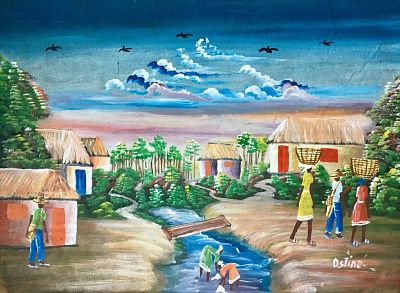 Sitting in on the orchestra sectionals and full rehearsal was right in our comfort zone. The three of us know orchestra music (collectively, the three of us have 70 years of experience in the Utah Symphony!), we know how to be efficient, give helpful cues, avoid making unnecessary waves, contribute to the whole, and be a stabilizing force. No need to speak in Creole, everything shown by example, and a few choice fingerings scribbled in the music took care of our job. The only force to be reckoned with was the weather. The evening orchestra rehearsals were virtually outdoors albeit under a corrugated metal roof. The roof and concrete slab of the “church” structure emanated heat, and sweat was dripping from everyone. After a full day of attempting to communicate physically, verbally, by any means necessary, we were already quite spent by 7 pm, when the orchestra rehearsal would begin. On one such evening, when everyone was sagging a bit, and the heat and humidity was building to breaking point, suddenly, a downpour of rain, thunder and lightening drowned out Rossini’s La Scala di Seta Overture with a deafening roar. The rain beating on the metal roof cooled the air instantly by a good ten degrees, but also put an end to our rehearsal. As students and faculty rushed to stow their instruments away from the leaky roof and windswept rain, a group of violin students spontaneously started playing. A kid would yell out the name of a piece, and they’d all join in a wild, raucous rendition accompanied by the howling storm. It was a moment I can’t forget. It was pure joy and camaraderie. It was an organic expression of their love of music, and how it pulls them through the tough moments in life. Their joy was infectious, and I feel like I’m still carrying a piece of that moment with me.
Sitting in on the orchestra sectionals and full rehearsal was right in our comfort zone. The three of us know orchestra music (collectively, the three of us have 70 years of experience in the Utah Symphony!), we know how to be efficient, give helpful cues, avoid making unnecessary waves, contribute to the whole, and be a stabilizing force. No need to speak in Creole, everything shown by example, and a few choice fingerings scribbled in the music took care of our job. The only force to be reckoned with was the weather. The evening orchestra rehearsals were virtually outdoors albeit under a corrugated metal roof. The roof and concrete slab of the “church” structure emanated heat, and sweat was dripping from everyone. After a full day of attempting to communicate physically, verbally, by any means necessary, we were already quite spent by 7 pm, when the orchestra rehearsal would begin. On one such evening, when everyone was sagging a bit, and the heat and humidity was building to breaking point, suddenly, a downpour of rain, thunder and lightening drowned out Rossini’s La Scala di Seta Overture with a deafening roar. The rain beating on the metal roof cooled the air instantly by a good ten degrees, but also put an end to our rehearsal. As students and faculty rushed to stow their instruments away from the leaky roof and windswept rain, a group of violin students spontaneously started playing. A kid would yell out the name of a piece, and they’d all join in a wild, raucous rendition accompanied by the howling storm. It was a moment I can’t forget. It was pure joy and camaraderie. It was an organic expression of their love of music, and how it pulls them through the tough moments in life. Their joy was infectious, and I feel like I’m still carrying a piece of that moment with me.
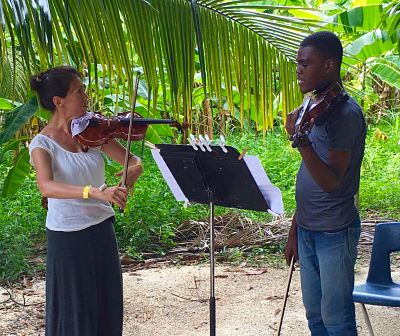
Aside from the staff building, the church structure and the tents, there were no practice rooms or rehearsal halls. Everything took place outdoors within the walled compound. It takes incredible focus to rehearse within earshot of other groups, but that is what these students did. My “teaching studio” was a certain spot under a certain tree until that spot became too muddy with the nightly downpours. A shady spot and an available music stand weren’t always easy to find, and yet, kids and volunteers were making lessons and rehearsals happen everywhere. Janet had told us that these summer music camps were often the musical highlight of a student’s year, and we saw clear evidence that they cherished this experience. The sheet music that the kids brought to the lessons were often faded and tattered photocopies of photocopies because xerox machines are also a luxury. The instruments being played were woefully in need of repair, and some of the bow hair for the violin students were so blackened with grease (rehairing the bow once a year, also not an option) or missing half of the hairs that I was impressed that they could even draw a tone. Despite the state of their equipment, there was a hunger for instruction that we sensed from the students. Perhaps because of my lack of verbal communication skills in their language, our lessons were very pure and direct. I showed by example, trying to be as clear as possible. The students were accustomed to receiving lessons in a mix of French, Creole, English, or Spanish since most of the volunteers were from overseas. Still, it was a relief when an occasional student spoke fluent American English, being a child of the Haitian diaspora, living in the States, and coming to Haiti for the summer for immersion in their parent’s culture.
There were Haitian luthiers (instrument fixers) also in training at the camp. Through a program called Luthiers Sans Frontieres (Luthiers without borders), professionals were training nearly a dozen students in the art of instrument maintenance using traditional methods as well as ingenious hacks using local materials.
There were plenty of terrific moments. We had the pleasure of performing Mozart’s Oboe quartet and Schubert’s two cello quintet with Janet and two new musician friends from the Dominican Republic and Denmark. Music is one of those rare fields where one can be total strangers one moment, and be playing chamber music together the next.
I got goosebumps while sitting in on the student orchestra dress rehearsal listening to a climactic moment in the finale of Sibelius Symphony No. 2. Here they were, working hard for every note, every crescendo, in Haiti’s stifling heat, playing music written over a century before in Finland. The absurdity of that contrast and the lovely reality of the music practically made me giggle. The effort it took for all the students and volunteers to be there really seemed to epitomise the mission statement of BLUME Haiti. I think all three of us felt that it was worth coming all this way to participate and witness this musical haven in Haiti. We were enchanted by the kids, affected by their earnest love of music, and made aware of our ridiculously comfortable lives.
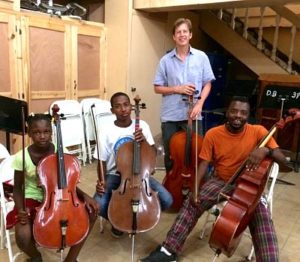 After our eye-opening week at the summer camp, we headed south to the coastal town of Jacmel, full of Colonial architecture and artists’ studios. We had planned it this way, to have a little beach vacation after the summer camp, because we knew the music camp would probably be taxing, and that we’d want to have a mini-vacation after our hard work. Checking into our air-conditioned hotel that had hot and cold water (!), a swimming pool and a restaurant felt like such guilty decadence. After the week in the walled compound following a daily schedule, it was a treat to unwind and just be tourists. We walked around the charming town center, we took a moto-taxi (the most common mode of transportation in Haiti – on the back of a motorcycle) to Bassin Bleu, a series of three natural pools and a waterfall in the hills above Jacmel, and spent some time on a sandy beach. We did visit the Dessaix-Baptiste Music School in Jacmel through Janet’s arrangement, and had the pleasure of teaching a few of the local cello, violin and oboe students one afternoon.
After our eye-opening week at the summer camp, we headed south to the coastal town of Jacmel, full of Colonial architecture and artists’ studios. We had planned it this way, to have a little beach vacation after the summer camp, because we knew the music camp would probably be taxing, and that we’d want to have a mini-vacation after our hard work. Checking into our air-conditioned hotel that had hot and cold water (!), a swimming pool and a restaurant felt like such guilty decadence. After the week in the walled compound following a daily schedule, it was a treat to unwind and just be tourists. We walked around the charming town center, we took a moto-taxi (the most common mode of transportation in Haiti – on the back of a motorcycle) to Bassin Bleu, a series of three natural pools and a waterfall in the hills above Jacmel, and spent some time on a sandy beach. We did visit the Dessaix-Baptiste Music School in Jacmel through Janet’s arrangement, and had the pleasure of teaching a few of the local cello, violin and oboe students one afternoon.
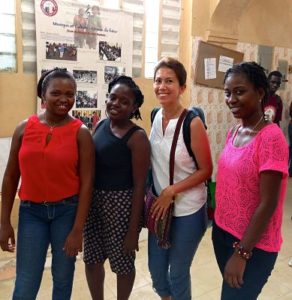 Visiting a well functioning music school in this lovely town gave John an idea. This idea started innocently enough with him daydreaming about a possible intersection of the wonderful students that we met while in Haiti, and our Utah Symphony colleagues (who are all seasoned performers as well as teachers), and our very pleasant stay in Jacmel . This idea has blossomed into the first Haitian Orchestra Institute, which is taking place in March, 2017 in Jacmel. A group of 15 Musicians representing every instrumental group from the Utah Symphony (and guest trombonist, David Binder, from the Detroit Symphony) will work with a total of 100 Haitian music students. It will be a week of intensive orchestral coaching and private lessons culminating with a performance at the end of the week, conducted by our Utah Symphony Music Director, Thierry Fischer. The majority of students bussed in from throughout Haiti will be provided with free room and board for the duration of the orchestra institute. The Utah symphony musicians are paying for their own travel, and using their vacation week for this exciting project.
Visiting a well functioning music school in this lovely town gave John an idea. This idea started innocently enough with him daydreaming about a possible intersection of the wonderful students that we met while in Haiti, and our Utah Symphony colleagues (who are all seasoned performers as well as teachers), and our very pleasant stay in Jacmel . This idea has blossomed into the first Haitian Orchestra Institute, which is taking place in March, 2017 in Jacmel. A group of 15 Musicians representing every instrumental group from the Utah Symphony (and guest trombonist, David Binder, from the Detroit Symphony) will work with a total of 100 Haitian music students. It will be a week of intensive orchestral coaching and private lessons culminating with a performance at the end of the week, conducted by our Utah Symphony Music Director, Thierry Fischer. The majority of students bussed in from throughout Haiti will be provided with free room and board for the duration of the orchestra institute. The Utah symphony musicians are paying for their own travel, and using their vacation week for this exciting project.
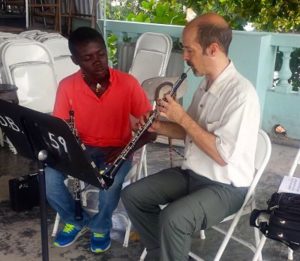 As soon as Maestro Fischer joined the project, the vision and reality of this project solidified. Fundraising has been nearly completed, thanks to Joanne Shiebler, a long time board member at the Symphony, who hosted several fundraisers and who rallied our very generous donor community around Salt Lake City. Our Symphony CEO, Paul Meechum loved the project right away, and offered logistical support in the form of the expertise and time of the Utah Symphony management team.
As soon as Maestro Fischer joined the project, the vision and reality of this project solidified. Fundraising has been nearly completed, thanks to Joanne Shiebler, a long time board member at the Symphony, who hosted several fundraisers and who rallied our very generous donor community around Salt Lake City. Our Symphony CEO, Paul Meechum loved the project right away, and offered logistical support in the form of the expertise and time of the Utah Symphony management team.
So here we are, about to embark on a new adventure, which will be eye-opening and life changing for both our Utah Symphony and our Haitian friends. We plan to post a daily blog while we are in Haiti, and you can find it at https://musiciansutahsymphony.com starting on March 26th.
